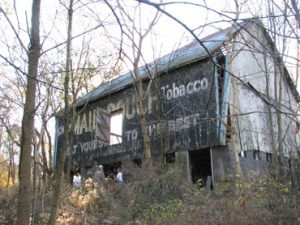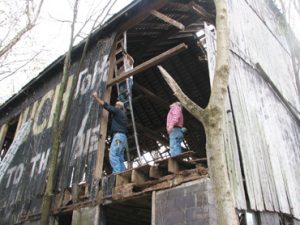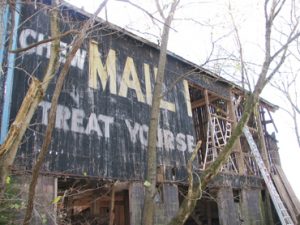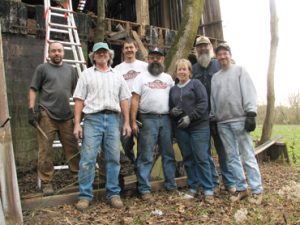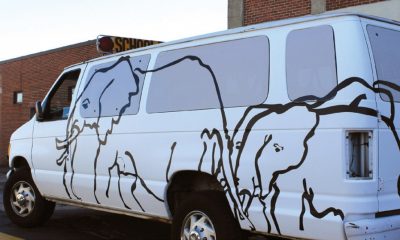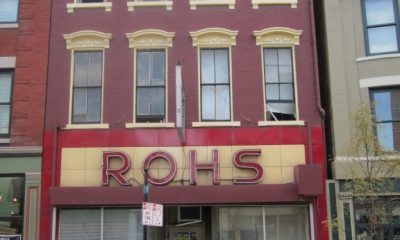The teamwork and community spirit of the old-fashioned barn raisings took a modern twist recently for the American Sign Museum when it turned into a barn “razing.” Well, maybe we were a little more careful than the usual connotation of “razing,” but I couldn’t pass up the wordplay.
To acquire a Mail Pouch barn, we first had to locate one of these rare structures, carefully dismantle the vertical, wooden boards and then diligently reassemble them.
A year ago, I contacted the Barnstormers, a grassroots group interested in preserving the history of Mail Pouch barns. The group tracks the existence and conditions of the approximately 1,000 barns that remain nationwide on its website, www.ohiobarns.com/ mpbarns.
Roger Warrick, the organization’s webmaster, and the son of the last Mail Pouch painter Harley Warrick, helped the museum spread the word about its interest in preserving a Mail Pouch barn.
Back in July, one of the Barnstormers, Dave Wawak of Hinsdale, IL, said his friend, Clyde Pitts, had learned about a barn near Lanesville, IN, that was set to be demolished. Pitts provided the property owner’s name and a phone number, and I called the owner, Scott Berkley, who confirmed the barn was ours for the taking. I called Roger back to let him know I was going to drive down to Lanesville and check it out.
Advertisement
I met Berkley at the site and further outlined who we are and our plans. The barn wasn’t in great repair, and, in fact, one of the back-corner posts was completely gone. I was concerned that, in the course of removing the front siding, we might compromise some of the barn’s remaining structural integrity and possibly subject it to collapse.
Having returned to Cincinnati, I mentioned the project to the museum’s new building architect, Paul Muller, who had provided a contact in Indiana with barn-preservation expert Scott Hunsinger. After several phone calls, Hunsinger was on board for the project and would probably bring a friend, Tracy Porter, to help. Things were starting to take shape.
Due to everyone’s busy summer schedules, we decided to wait until mid-September to tackle the take-down. Eventually, we agreed on October 26, but when that week rolled around, the weather predictions called for heavy rain. We postponed poned until the following Monday, October 30.
Hunsinger hadn’t seen the barn yet, and I had explained my concerns. I asked him to advise us if we would need to stabilize the barn’s structures before removing the siding. The last thing I wanted was for the barn to collapse when we were in it. So, I loaded tie-down straps and 2 3 6s/2 3 4s onto my trailer if the situation called for such engineering.
Advertisement
Monday morning, a museum-crew caravan drove the 100 miles to Lanesville, which is just south of I-64 and roughly 30 miles west of Louisville. Riding with me was my girlfriend, Barbara Marrow, from Washington, DC, who had flown in just for the project. Behind us were the museum’s display builder, Sean Druley, and his buddy, Chris “Snappy” Vorhees, who had loaded Sean’s van with power tools and a generator. Behind them was Jennifer Miles, art director at ST Media Group and the project’s unofficial photographer and videographer.
When our group arrived, we found Warrick already there, and Hunsinger and Porter, who had set out much earlier to make the 150-mile drive from their homes in central Indiana.
As it turned out, the postponement was fortunate because the weather was low 60s and blue skies: Not bad for late October! More fortuitously, Hunsinger looked the barn over and assured us it wasn’t going anywhere. The late-1800s structure comprised hardwood beams, he told us, and had been mortised-and-tenoned together with wood pegs. After a brief strategy session, we all set to work.
The 50-ft.-long barn had been built into the hillside, with the Mail Pouch side facing downhill. We planned to remove the vertical boards from the inside of the barn, working on ladders at floor level, and then lower them one by one to waiting crew members below. Each board was consecutively numbered from inside the barn to facilitate re-assembly at a later date.
The barn originally had sliding doors, so the exterior track railing had to be removed first. Fortunately, we had brought an oversized ladder. Also, we removed intact a hayloft hinged door, on which the bottom corners of the “O” and “U” in “MAILPOUCH” were painted.
Fortunately, the only hitch to the project, the severely weathered boards below floor level, didn’t affect any of the painted Mail Pouch copy. We snapped a line and cut off the rotted wood, leaving a 13-ft. 8-in. consistent height.
Advertisement
We began removal around 10 a.m., and finished by 4 p.m., including the loading of the individual boards in numerical order on the museum’s 16-ft. flatbed trailer.
The project seemed pre-ordained. The story ended up on the Associated Press wire, as well as on the cover of Antique Trader. But the final chapter won’t be written until we re-assemble the 50-ft.-long Mail Pouch ad on the wall of the signpainting-themed area of the museum’s new home. Stay tuned.
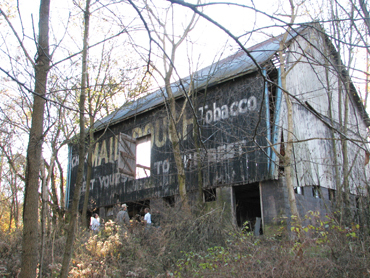

 Tip Sheet2 days ago
Tip Sheet2 days ago
 Business Management1 week ago
Business Management1 week ago
 Women in Signs2 weeks ago
Women in Signs2 weeks ago
 Real Deal3 days ago
Real Deal3 days ago
 Editor's Note1 week ago
Editor's Note1 week ago
 Maggie Harlow2 weeks ago
Maggie Harlow2 weeks ago
 Line Time2 weeks ago
Line Time2 weeks ago
 Product Buying + Technology1 week ago
Product Buying + Technology1 week ago
